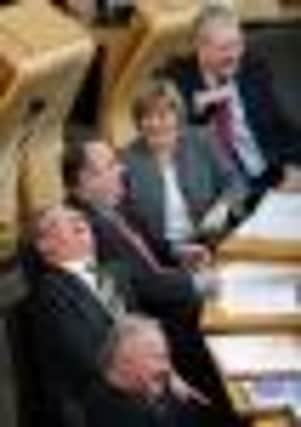Salmond taken to task on university mergers ‘hit list’


At First Minister’s Questions at Holyrood, the Labour leader Iain Gray asked Mr Salmond if Abertay featured on what he described as a “hit list” drawn up by Education Secretary Michael Russell.
The day after the SNP government unveiled its budget and spending review for the next three years, the Labour leader said he was concerned that cuts to education funding would see the closure of universities and colleges.
Advertisement
Hide AdAdvertisement
Hide AdThe matter was raised by the outgoing Labour leader following concerns that Abertay could be forced into a “shotgun wedding” with Dundee University.
The concerns emerged after the Scottish Funding Council called for the recruitment of a new principal at Abertay to be delayed.
Professor Bernard King confirmed his retiral from Abertay last month after he was controversially suspended by the institution earlier in the year.
Abertay is one of the smallest universities in the UK, about half the size of the average institution.
It has a roll-call of about 3,250 full-time undergraduates, 600 postgraduates and 500 staff. Its neighbour, Dundee, has about 17,000 students and 3,000 staff.
Mr Salmond side-stepped Mr Gray’s question by quoting the principals of Edinburgh and Glasgow Universities, Professor Sir Timothy O’Shea and Professor Anton Muscatelli, who had welcomed the higher education funding announced in John Swinney’s budget.
But Mr Gray replied saying that the SNP leader may not have plans to shut Glasgow or Edinburgh universities, but added that it was universities like Abertay that were under fire.
Mr Gray said: “He’s going to close Abertay University. Five hundred staff and 5,000 students. The best university in this country in environmental science and in computer gaming. They are top of Mike Russell’s hit list.
Advertisement
Hide AdAdvertisement
Hide Ad“Will the First Minister tell us now, yes or no, is he going to close Abertay?”
Mr Salmond did not respond to the direct challenge, but accused Mr Gray of “misrepresenting” his education secretary. Mr Salmond said: “Given that nobody in this country believes that the Labour Party, if they’d been in government, would have funded our universities to anything like this extent, can Iain Gray now find it within himself to agree with Universities Scotland, to quote the words of Anton Muscatelli, that this is a fantastic settlement for universities?”
Later Labour’s Jenny Marra, a North East MSP, returned to the issue, re-phrasing the question to ask if Mr Russell favoured the merger of Abertay and Dundee universities.
Mr Salmond said: “That is of course not what Iain Gray asked. As I tried to point out a number of times, Iain Gray twice said that the cabinet secretary had proposed the closure of further and higher and university institutions.
“The cabinet secretary never did any such thing. He opened up the possibility of mergers as we’ve seen in the further and higher education sector, and indeed the university sector.”
The departing Conservative leader Annabel Goldie challenged Mr Salmond to use the existing powers of the parliament to help businesses.
Ms Goldie called on Mr Salmond to cut business rates instead of concentrating on his attempts to devolve control over corporation tax to Holyrood.
She said reducing the rates paid by “the vast majority of all businesses in Scotland” would help create jobs, while lowering corporation tax would only benefit a small proportion of firms.
Advertisement
Hide AdAdvertisement
Hide Ad“According to the Scottish Parliament’s own research, fewer than three per cent of businesses in Scotland would benefit.
“By the government’s own admission, the creation of their estimated 27,000 new jobs by reducing corporation tax would take 20 years.
“I am all in favour of cutting tax for business, but the First Minister has got a tax power that he can use right now, and it’s called business rates, paid by the vast majority of all businesses in Scotland, not just three per cent.”